I Was Wondering What's Your Process For Creating Plants? Specifically Where You Have To Create Leaves/flowers/branches
I was wondering what's your process for creating plants? Specifically where you have to create leaves/flowers/branches out of a stem.
i really enjoy making flowers. basically, when i find one that looks fun to model, i’ll get a few photo references of real flowers, like this one from Home Depot’s website

so i can get a basic idea of their colors and shapes.
after that, i pretty much just make each component separately, one piece at a time. the stem, pistil, and stamen are essentially just long cylinders that widen and narrow at the ends, the leaves and petals start out as circles that i shape and alter over time, and then after coloring and detail work is done i move each separate model into place so that they start to resemble a complete flower


it’s kind of like putting a puzzle together, except you also make each of the pieces.
More Posts from Nastysynth and Others
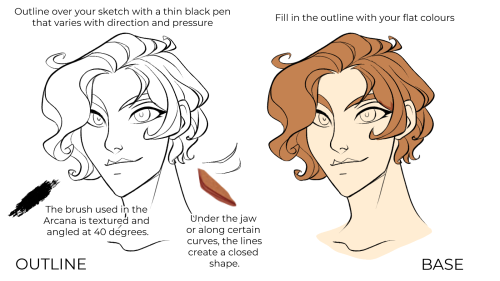
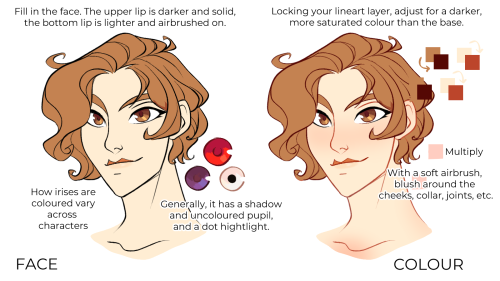
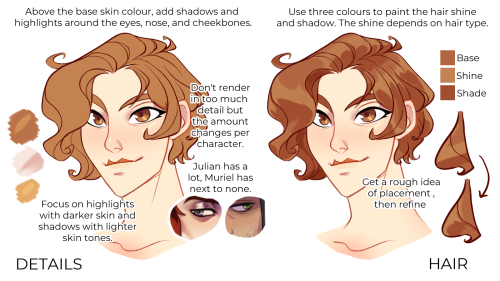
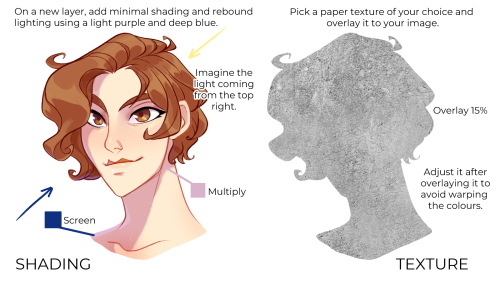
A guide on my process for colouring like in the Arcana which I developed through studying the style.
Now, this is just for sprites or for neutral lighting. In the case of most memories/CGs, you have more interesting colours to use, but the process is identical. There are just extra steps.

Using my favourite memories for each character as examples (hopefully, you can tell which ones) you can see this process. All of this happens on layers above the base drawing.
Usually, you set a colour-filled layer to the setting “multiply” over the entire drawing, then using a “screen”, “add”, or “hard light” layer, you add the lighting. Depending on the intensity of the lighting, the outline will be coloured to be lighter.
The shading colour rarely changes, aside from slight hue changes.
Misc advice/tips/tricks below. I may update it depending on if I get further questions.
Czytaj dalej
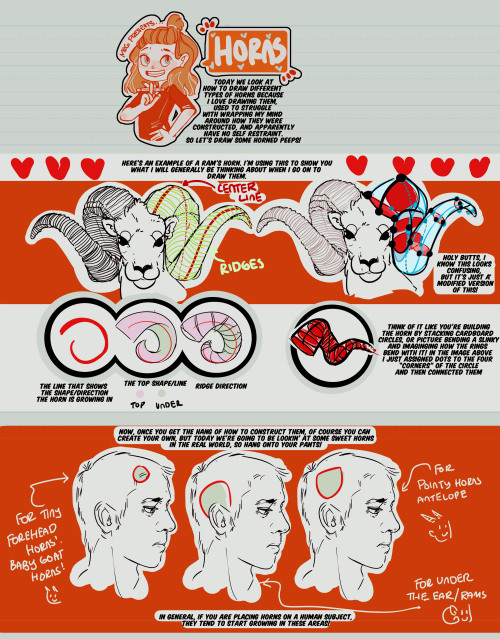
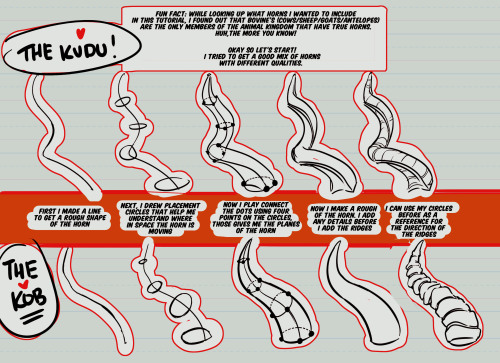
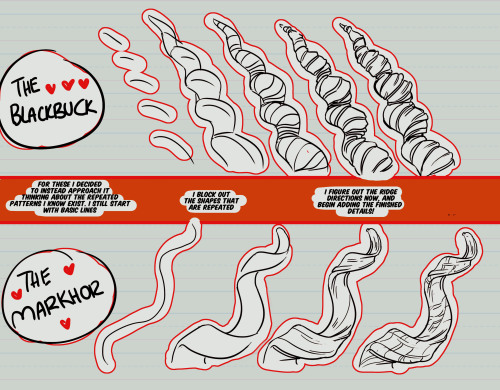
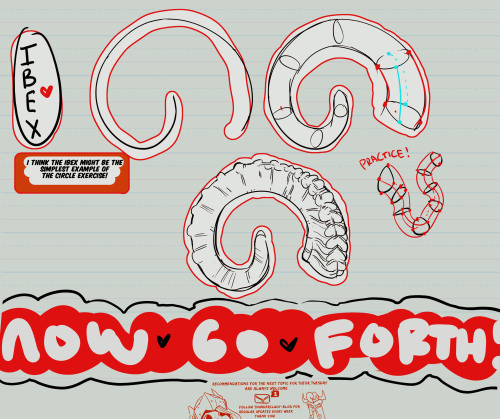
Hey friends!
It’s Meg for this week’s TUTOR TUESDAY! Today we take a little look at hopefully some exercises that will help with drawing horns! So go draw some peeps with horns, my dudes. If you have any recs send ‘em in here or my personal. Keep practicing, have fun, and I’ll see you next week!
i literally love how your color and shade if it’s ok do you have any tips on digital coloring? you don’t have to answer this if you don’t feel like it :) thanks!!
hello friend!! i have a tutorial i made on twitter a while ago which is more or less how i make my colours more interesting. i still use the technique and in general it’s just a lot of colour adjustment nothing too special LOL here!!









do you have any tips for drawing a nose when the face is front facing?
This was really fast but I hope this helps:

Depending on the shape of the nose, the way you chose to render the contour lines will change. I used Rose, Quazky, and Glasner as examples in the lower right corner there. For TH, I generally don’t render the bottom of the nose with a line but with a shadow for simplicity’s sake. I hope that makes sense.
PS - I made a new brush for rendering technical drawings and I love it. *A*
About Yarovit-Yarilo

Today I present you my translation of fragments of two polish academic publications that are great favorites of mine. Fragments chosen are centered around Yarovit and Yarilo. My own comments will be indicated by a „trans. note” disclaimer. The fragments below are merely a part of larger text. I apologize for any context lost to the lack of broader perspective on the whole of the publication.
Mitologia Słowian by Aleksander Gieysztor
Chapter V: Principal deities and myths
Subchapter: „Perun’s many ways - Sventovit, Ruyevit & company, Yarovit-Yarilo”
Yarovit-Yarilo
A deity called Yarovit (trans. note: Herovith, Gerovit, pl: Jarowit) was worshipped in two locations settled by polabian Slavs - in pomeranian Wolgast and in Havelberg, a gord inhabited by the Brizans tribe (pl: Brzeżanie). During the mission of bambergian bishop Otton in Wolgost in 1128 one of his priests hid from an angry crowd in a pagan temple, and there found a giant shield covered in golden plates, that was considered untouchable and would only be carried out during war time, as a blessing of good luck. The preacher snatched the sacred shield and ran back out of the temple terrifying the pursuing crowd - in the sput of the moment they thought they see Yarovit himself. One of the writers compares him to Mars, another calls him the god of war - there is no doubt Yarovit was a martial god. It’s hard to tell if there was any statue in his temple, as the escaping priest only noticed the shield. A shield is a ritual object in many martial cults, for example in roman Regia (trans. note: royal house on the ancient Forum Romanum) a most sacred shield was watched over by guards. So called „Stone of Yarovit” in St. Peter’s church of Wolgast (trans. note: Wolgast is now located in the northeast corner of Germany) is a tombstone dating to the earliest christian times. One of the polabian villagers saw Yarovit appear to him „in the robes of his idol” to warn him about the coming missionaries - so there seems to have existed some idol/statue of him (trans. note: episode from Vita s. Ottonis III by Ebonis).
There are no doubts as to the origin of this deity’s name. It came from the root jar-, jaro- meaning strength or severity, but also conveying the idea of stregth coming from youth, as in slavic word „jar” meaning spring. Similar military competences and analogical anatomy of the names strongly connect Yarovit and Sventovit (pl: Świętowit) with one another and with Perun - the supreme warrior god. We could try to follow Ivanov and Toporov (trans. note: famous russian folklorists) in their attempts to strengthen this thesis by means of analysing folklore and comparative religious studies. The baseline for all scholars here is belarusian text from 1846 describing Yarilo as a young man in white robes, barefoot, with human head under his right arm and stalks of rye in his left hand, in a herbal wreath, on a white horse. A ritual, which took place on 27th of April, to welcome spring before the first plowing, was performed by a procession of young girls, one of them dressed as Jarilo, sitting on a white horse, the others singing to her
„Yarilo wandered all over the world / Rye grew high in the fields, he gave women children / And where he set his foot/ There a stack of rye / Where he’s in the grain/ There the stalks grow tall”
Along Yarovit and Yarilo there is also a third name entangled in the cult practices, „Yarun” (pl: Jarun), a ruthenian idol named in Laurentian Codex, as well as a collection of common slavic words, ruthenian „jarovoj” - „of spring” „vernal”; polish word „jare” used to describe grains planted in the spring (trans. note: as opposed to „ozime” grains growing over the winter), ruthenian and czech word for spring „jar”.
As much as we can question the date and quality of this belarusian text it’s undeniable that there is an archaic note ringing in those beliefs - white robes and white horse, flowers and rye stalks, the head held by a victorious rider, the barefoot man, touching the earth with his feet in a cultically significant way, making grain sprout wherever he steps, opening the fields in the spring, with his name, the surveying of the fields. He has been accepted, his traits amalgamated with those of St. George (Sveti Jurij) who is celebrated in some places on 23rd of April (trans. note: julian, not gregorian), accompanied by burning of female effigy called Marena/Marzanna, personifying winter or death, a harbinger of spring. Sometimes young Yarilo is juxtaposed with the old Yarilo, who gives up his place - perhaps loses it in a fight with his young rival.
We can see a bit of a duality shaping up in the image of Yarovit-Yarilo-Yaruna. On one hand he is a warrior, on another an overseer of agricultural activity, which, despite Ivanovs and Toporov’s opinions, doesn’t take any odd naturalistic interpretations on the part of the people as it naturally belongs to the dominion of supreme deities - even Jupiter comes down to bless the roman farmer during his spring festival Vinalii, that falls on… 23rd April.
We also need to examine the toponimastic evidence: the city of Jarilovo and no less than four settlements called Jarilovic in the area od Novogrod the Great. In 18th century diocese of Voronezh festivities were held around an idol called Yarilo from Wednesday to Friday or Saturday in the week after Green Week, as late as 1673 a man would lead the festival, adorned with flowers and bells, with his face painted red and white.
Religia Słowian by Andrzej Szyjewski
Chapter V: The Lost Gods
Subchapter: „Deities of fertility and vegetation”, fragments
We can see the solar hero association even more prominently in Yarovit, worshipped in Wolgast and Havelberg. His very name „Yarovit”, „The Young Victor” is connected to spring, youthful strenght and sexual passion (as in slavic words „jar” - spring, „jurny” - virile, manly, or the phrase „stary ale jary” meaning something along the lines of „old but tough”). This particular god watched over the fertility of fields and forests, humans and beasts - or so we can guess from the threats of Yarovit’s priest made against all those who will choose the „german god” (trans. note: abrahamic god) over their local deity. In Wolgast a sacred golden shield of Jarowit was held described as „great of size and exquisitely made”, a clear solar symbol, that nobody but the god or his priest could touch. As the greatest sanctity in the temple to the polabians it was also a symbol of victory - let’s not forget that Otto of Bamberg describes Yarovit as a war god similar to Mars. As the greatest, untouchable sacred object, and at the same time the harbinger of victory it corresponds fully in its symbolism to the white horse of Sventovit. In the „Vita s. Ottonis” we find a clear reference to Yarovit as the god of military, his name is translated into latin as „Mars” („deo suo Gerovito, qui lingua Latina Mars dictur). Just like with Sventovit we see a trio of interconnected associations: fertility - solar hero - war.
The celebrations of Yarilo mentioned by the missionaries of Otto were likely the planting festival of 15th April. It could involve the god’s „descent” among the people, enacted with the help of the sacred shield. That the god spoke through the lips of żerca (slavic priest) we know from other versions of „Vita s. Ottonis” (trans. note: hagiographic writings about Saint Otto). Scholars try to reconstruct the pre-christian celebrations through XVIII century ethnographic materials concerning Yarilo (admittedly not Yarovit), with ruthenian and belarusian origins. Texts recovered from diocese of Voronezh mention local bishop putting an end to the festivities surrounding Yarilo held on 23rd April in julian calendar (15th of April corresponds in gregorian). In christian context Yarilo is replaced by Saint Jurij (description of the same ritual as one described above follows, girl dressed up as Yarilo, the same song). People would dance circle dances (korovod) on top of the freshly planted fields and end the day with a feast with orgiastic elements. The purpose of the rituals was to close the winter and open the spring; Yarilo opens the gates of earth, letting the spring out.
Yarilo’s attributes clearly point to his role as god of vegetation and fertility. The girl assuming his likeness during the festival, also known as Wiosnołka or Wiesnowka (trans. notes: pronounciation „vyos-NOHW-kah” or „vyes-NOHV-kah”) could be an echo of „divine bride”, an offering to the god, an incentive to arrive with the spring. Many songs refer to Yarilo causing the earth to sprout and bloom as he walks but also summoning dancing girls to him. Circle dances, white robes, white horse and the cut off head are all elements of solar symbolism. The head belongs to Old Yarilo, dethorned and overpowered by his young son. All over the world similar symbols exist - from celtic Curoi to mayan Hunahpu. Young Yarilo matures and dies as the harvest unfolds, then at the end of summer a funeral is held - this time main roles were played by young married women not maidens. They made an effigy of Yarilo (putting some extra effort into shaping his reproductive organs) that they called Kostrub („COST-roob”) and then they put him into his grave, in the ground since in the earth the sun loses it’s powers and dies, letting the new sun take over. The people would sing and cry out about Yarilo dying and ask him to get back on his horse in his golden saddle. Attempts to reconstruct the rituals seem to show that young Jarilo on white horse was juxtaposed with old Yarilo on black goat. Southern slavs practice similar rituals of burning old Badniak (a piece of wood with forked roots) on Christmas Eve to make place for young Božič (son of god). Western Slavs don’t have a deity corresponding to Yarilo - they close the winter in rituals involving Marena/Marzanna, followed by a procession carrying around „maik” or „nowe lato” symbolized by the peak of an evergreen coniferous tree or a rooster as a solar bird.
The Slavs were an agricultural society so agrarian deities were their primary source of relations with divine, cosmic forces. There is a certain myth/archetype that is characteristic for early farmers, the myth of creative murder, in which the first birth, growth and harvest are prompted by the first death - death of a deity, hero, ancestor, who dies sacrificing himself for the people, and from his body the first plants spring, allowing the people to survive. That myth, encated in many cultures in many ways leads to the cincept of a solar god that dies and is reborn cyclically, whose individual fate is reflected by the cycle of growing grain. The stalks loose their heads under the sickles for people to be able to feed. Yarilo (and maybe even Yarovit) makes identical sacrifice.
Art: Jaruna by Ada Konieczna






























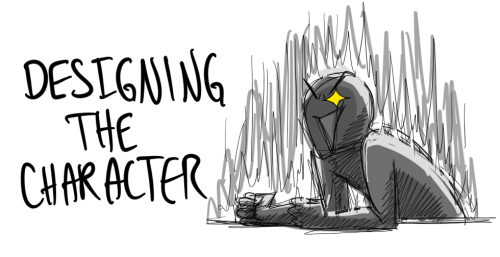

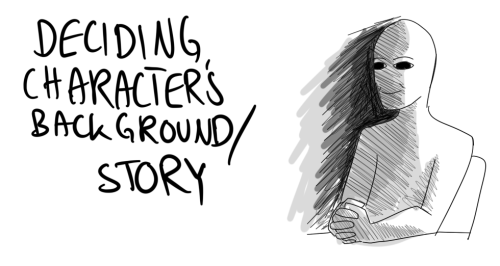

the suffering never ends
Hi! regarding your latest post, may I know which brushes and program did you use for it? Thanxx


I used Clip Studio Paint, the Rough brush is a standard brush in the program. Rough 2 is a variation of Rough (settings above), and Rough 3 is the same as Rough 2 + an extra marble texture. Hope that was helpful :)
Art tips for facial features?
I would love to help but you need to be bit more specific. “facial features” can mean a lot of stuff.
Most vague tip i can give is uh - silhouette, shapes and proportions: silhouette helps block out unique features, geometric shapes can aid with structure and keeping the same face consistent between drawings, and proportions convey characteristics like age easily to the viewer.



-
 irridreamz liked this · 6 months ago
irridreamz liked this · 6 months ago -
 hueywheel liked this · 10 months ago
hueywheel liked this · 10 months ago -
 disco848 liked this · 11 months ago
disco848 liked this · 11 months ago -
 dzziiy liked this · 1 year ago
dzziiy liked this · 1 year ago -
 chunrao liked this · 1 year ago
chunrao liked this · 1 year ago -
 nemumori liked this · 2 years ago
nemumori liked this · 2 years ago -
 irina-s liked this · 2 years ago
irina-s liked this · 2 years ago -
 ace-space-rock liked this · 2 years ago
ace-space-rock liked this · 2 years ago -
 rinkaia liked this · 2 years ago
rinkaia liked this · 2 years ago -
 chocopulse liked this · 2 years ago
chocopulse liked this · 2 years ago -
 sakurasphinx liked this · 2 years ago
sakurasphinx liked this · 2 years ago -
 laconicaddict liked this · 2 years ago
laconicaddict liked this · 2 years ago -
 chocopulse reblogged this · 3 years ago
chocopulse reblogged this · 3 years ago -
 nkulunkulu liked this · 3 years ago
nkulunkulu liked this · 3 years ago -
 farcito liked this · 3 years ago
farcito liked this · 3 years ago -
 captainthembo reblogged this · 3 years ago
captainthembo reblogged this · 3 years ago -
 captainthembo liked this · 3 years ago
captainthembo liked this · 3 years ago -
 esideaccount liked this · 3 years ago
esideaccount liked this · 3 years ago -
 okidoki-studios liked this · 3 years ago
okidoki-studios liked this · 3 years ago -
 xvix liked this · 3 years ago
xvix liked this · 3 years ago -
 cherry-flavored-sigh liked this · 3 years ago
cherry-flavored-sigh liked this · 3 years ago -
 defiantinsect liked this · 3 years ago
defiantinsect liked this · 3 years ago -
 luminousespeon liked this · 3 years ago
luminousespeon liked this · 3 years ago -
 creaturecabaret reblogged this · 3 years ago
creaturecabaret reblogged this · 3 years ago -
 creaturecabaret liked this · 3 years ago
creaturecabaret liked this · 3 years ago -
 jadedpen liked this · 3 years ago
jadedpen liked this · 3 years ago -
 anonymouseyesamongwalls liked this · 3 years ago
anonymouseyesamongwalls liked this · 3 years ago -
 quinn-gemstone liked this · 3 years ago
quinn-gemstone liked this · 3 years ago -
 heckoffmate reblogged this · 3 years ago
heckoffmate reblogged this · 3 years ago -
 heckoffmate liked this · 3 years ago
heckoffmate liked this · 3 years ago -
 alexneedsref reblogged this · 4 years ago
alexneedsref reblogged this · 4 years ago -
 alexpetit liked this · 4 years ago
alexpetit liked this · 4 years ago -
 shadowlink-44 liked this · 4 years ago
shadowlink-44 liked this · 4 years ago -
 nastysynth reblogged this · 4 years ago
nastysynth reblogged this · 4 years ago -
 nastysynth liked this · 4 years ago
nastysynth liked this · 4 years ago -
 3ji liked this · 4 years ago
3ji liked this · 4 years ago -
 chill-alexandria liked this · 4 years ago
chill-alexandria liked this · 4 years ago -
 fileszero liked this · 4 years ago
fileszero liked this · 4 years ago -
 joklarodky liked this · 4 years ago
joklarodky liked this · 4 years ago -
 gabieboo liked this · 4 years ago
gabieboo liked this · 4 years ago -
 theghostadrift liked this · 4 years ago
theghostadrift liked this · 4 years ago -
 antiherotheantisocial liked this · 4 years ago
antiherotheantisocial liked this · 4 years ago -
 pioupiesque liked this · 4 years ago
pioupiesque liked this · 4 years ago -
 bottecellibabe liked this · 4 years ago
bottecellibabe liked this · 4 years ago -
 toastyboobs reblogged this · 4 years ago
toastyboobs reblogged this · 4 years ago

Sylwester | i will mostly post sketches, because i'm too lazy to end them
196 posts